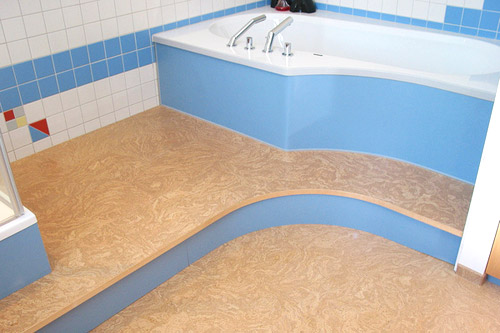Cork flooring pros and cons
Cork bathroom flooring is one of the most environmentally friendly and safe building materials, corresponding to the demands of bathroom conditions: warmth and humidity. This amazing material consists of gases by 87%. Cork floor for bathroom can be called the best alternative to expensive ceramic tile.
Why is cork flooring good for bathrooms?
The answer is simple: cork flooring for bathrooms has lots of advantages. Let us dwell on cork flooring in bathroom pros and cons. First of all, cork is relatively warm. Tiles, for example, do not have this advantage. It is unpleasant to walk barefoot on the tiled floor. To solve this problem you can install floor heating, which sufficiently increases the costs of repair and maintenance. Besides, tiled floor is prone to fungus and bacteria.
Cork floor in bathroom is completely devoid of these problems. Its natural warmth and pleasant tactile sensations are highly valued. It is extremely pleasant to walk on cork floors in bathrooms due to their warmth and softness. In addition such floor is very useful, because it has shock absorbing effect, which reduces the load on your spine. Cork flooring in bathroom is resistant to moisture and chemical affect, and regains its original shape even after long-term deformation. So you can put bathroom furniture on it.
Cork flooring for bathroom is also resistant to fungi and bacteria, which like to multiply in wet areas such as bathrooms. Cork flooring in bathrooms is difficult to spoil, as cork is a very durable material. It is resistant to dirt and quite easy to clean.
The only drawback of cork bathroom flooring is its price. It is rather expensive. But if you decide to use cork tiles for bathroom, you can save money on floor heating. Besides, the insulating properties of cork perfectly help to abstract from external sounds, because cork is an excellent natural sound insulator.
Types of Cork Flooring and Its Features
Cork floor in bathroom has several features, among which are the following:
- It is made of cork tiles glued together with a special glue;
- It has a fairly smooth surface coated with a protective varnish;
- There are two kinds of its installation: glued and floating cork floors in bathroom;
- Floor surface has to be ideally smooth before you start applying the cork tiles for bathroom.

Cork is obtained from the bark of cork oak peeled once every 9 years. It explains relatively high cost of cork floors in bathroom. Nowadays there are three basic kinds of decorative cork: one-piece veneer, coatings based on granulated cork and materials that combine both types.
- The first type of cork, cork veneer, is quite expensive, because only solid sheets are used for its production;
- The second type based on granulated cork is the most democratic option, because even the smallest pieces of cork bark are used in its manufacturing;
- The third type of cork flooring combines properties of the first and second types. Respectively, its price range is average.
Cork Floor Installation
How to install cork flooring in bathroom depends on what material you choose. It is relatively easy to install, so you can try doing it yourself. But to be on the safe side find an experienced person to make cork flooring for bathroom for you.
The modern market offers an alternative solution – sprayed cork. This material has all the positive qualities of cork, and is completely devoid of drawbacks. Due to the fact that it is liquid, sprayed cork is easy to apply. Spraying can be made on any surface. You can apply liquid cork on a wet surface and the moisture evaporates on its own.
If you decide to install cork floor in your bathroom you will not regret this decision in future.

